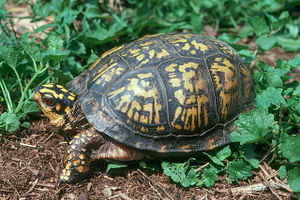In the wild, few box turtles live more than 40 years, but some may live a century or more. They live a decade or more before they become sexually mature and begin to breed.
Photo Credit: Geoffrey A. Hammerson
Terrapene carolina
Common Name: eastern box turtle
Other Common Names: Florida box turtle, Gulf Coast box turtle, three-toed box turtle
Animal Guild: Reptile
Class > Order > Family: Reptilia > Testudines > Emydidae
What does the species look like?
The upper shell is hard, domed, arched, and generally has evidence of a low keel. Upper shell coloration is highly variable but often has a bold or more subtle pattern of yellow, orange, or olive markings on a dark brown or black background. The lower shell is transversely hinged in adults, allowing the shell to be tightly closed. Maximum straight-line length of the upper shell is about 8.5 inches (22 cm). In mature males, the iris and spots on the forelimbs may be red, the rear portion of the lower shell is concave or not, and the vent is located beyond the rear edge of the upper shell when the tail is extended. In mature females, the vent is at or inside the rear edge of the upper shell when the tail is extended.
Where is the species found?
States & Provinces
AL, AR, CT, DC, DE, FL, GA, IA, IL, IN, KS, KY, LA, MA, MD, ME, MI, MO, MS, NC, NH, NJ, NY, OH, OK, ON, PA, RI, SC, TN, TX, VA, WV
Distribution
Range extends from southern New England to Michigan, southern Iowa, and eastern Kansas, and south to eastern Texas, the Gulf Coast, and southern Florida; also Campeche, Quintana Roo, Yucatan, San Luis Potosi, Tamaulipas, and Veracruz, Mexico.
Eastern box turtles inhabit forests, fields, bottomlands, forest-brush, and forest-field ecotones. In some areas they move seasonally from fields in spring to forest in summer. They live on land but commonly enter pools of shallow water in summer. For shelter, they burrow into loose soil, debris, mud, old stump holes, or under leaf litter. They can successfully hibernate in sites that may experience subfreezing temperatures.
General Phenology and Life History
Activity occurs during daylight hours in spring and fall, but in hot summer weather most activity is in the morning and after rains. Box turtles sometimes bask in the sun, especially after a cold night. Box turtles are generally inactive during cold winter weather. Courtship and mating may occur at various times, beginning just after emergence from hibernation and extending throughout the warmer months. The egg-laying period in most of the range extends from May through July (mainly June in Maryland, primarily June-July in Louisiana). Adult females lay one or more clutches of usually 1-8 eggs. Egg laying sites often are sandy or loamy soils in open areas; females may move from bottomlands to warmer and drier sites to nest. Eggs hatch in about 2-3 months, often in August, September, or October; hatchlings may overwinter in the nest.
Which phenophases should I observe?
Do you see/hear...?
Activity
Individuals on land More...
For abundance, enter the number of individual animals observed in this phenophase.
Individuals in water More...
For abundance, enter the number of individual animals observed in this phenophase.
Feeding For abundance, enter the number of individual animals observed in this phenophase.
Reproduction
Nesting For abundance, enter the number of individual animals observed in this phenophase.
Development
Young individuals For abundance, enter the number of individual animals observed in this phenophase.
Dead individuals For abundance, enter the number of individual animals observed in this phenophase.
What do these phenophases look like?
There is currently no photoguide available for this species. If you'd like help us create one, use the guidance document and species template provided here . Then send it via email to education@usanpn.org when it is complete.
